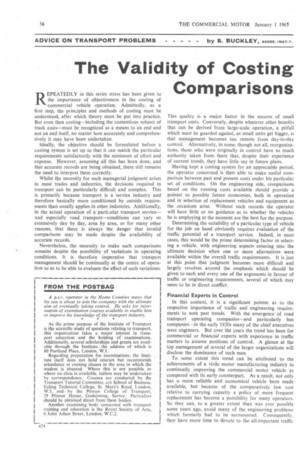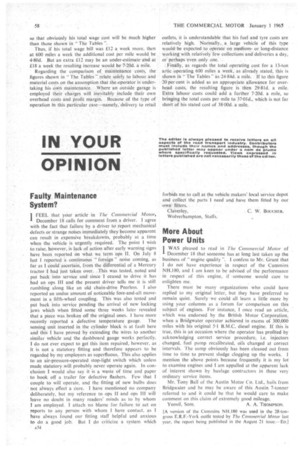ADVICE ON TRANSPORT PROBLEMS by S. BUCKLEY, Assoc. iNST.7.
Page 58

Page 59

Page 60

If you've noticed an error in this article please click here to report it so we can fix it.
The Validity of Costing Comparisons
REPEATEDLY in this series stress has been given to the importance of objectiveness in the costing of commercial vehicle operation. Admittedly, as a first step, the principles and methods of costing must be understood, after which theory must be put into practice. But even then costing—including the contentious subject of track costs—must be recognized as a means to an end and not an end itself, no matter how accurately and comprehensively it may have been undertaken.
Ideally, the objective should be formulated before a costing system is set up so that it can match the particular requirements satisfactorily with the minimum of effort and expense. However, assuming all this has been done, and that accurate records are being obtained, .there still remains the need to interpret them correctly.
Whilst the necessity for such managerial judgment arises in most trades and industries, the decisions required in transport can be particularly difficult and complex. This is primarily because transport is a service industry and therefore basically more conditioned by outside requirements than usually applies in other industries. Additionally, in the actual operation of a particular transport service--and especially road transport—conditions can vary so extensively day by day, area by area, or for many other reasons, that there is always the danger that invalid comparisons may be made despite the availability of accurate records.
Nevertheless, the necessity to make such comparisons remains despite the possibility of variations in operating conditions. It is therefore imperative that transport management should be continually at the centre of operation so as to be able to evaluate the effect of such variations.
This quality is a major factor in the success of small transport units. Conversely, despite whatever other benefits that can be derived from large-scale operation, a pitfall which must be guarded against, as small units get bigger, is that management becomes too remote from day-to-day control. Alternatively, in some, though not all, reorganizations, those who were originally in control have so much authority taken from them that, despite their experience of current trends, they have little say in future plans.
Having kept a costing system for an appreciable period, the operator concerned is then able to make useful comparison between past and present costs under his particular set of conditions. On the engineering side, comparisons based on the running costs available should provide a pointer to possible future economies, both in operation and in selection of replacement vehicles and equipment as the occasions arise. Without such records the operator will have little or no guidance as to whether the vehicles he is employing at the moment are the best for the purpose.
Determining the suitability of a particular type of vehicle for the job on hand obviously requires evaluation of the traffic potential of a transport service. Indeed, in most cases, this would be the prime determining factor in selecting a vehicle, with engineering aspects entering into the ultimate decision when one or more alternatives were available within the overall traffic requirements. It is just at this point that judgment becomes more difficult and largely revolves around the emphasis which should be given to each and every one of the arguments in favour of traffic or engineering requirements, several of which may seem to be in direct conflict.
Financial Experts in Control In this context, it is a significant pointer as to the respective importance of traffic and engineering requireMents to note past trends. With the emergence of road transport operating companies—and particularly bus companies—in the early 1920s many of the chief executives were engineers. But over the years the trend has been for commercial or financial experts with experience in traffic matters to assume positions of control. A glance at the top management of several of the larger organizations will disclose the dominance of such men.
To some extent this trend can be attributed to the achievements of a virile motor manufacturing industry in continually improving the commercial motor vehicle as compared with its early counterpart. As a result, not only has a more reliable and economical vehicle been made available, but because of the comparatively low cost relative to carrying capacity a policy of more frequent replacement has become a possibility for many operators. So they can, to a greater extent than was ever possible some years ago, avoid many of the engineering problems which formerly had to be surmounted. Consequently. they have more time to devote to the all-important traffic
which provides their livelihood—whether hauliers, p.s.v. or ancillary operators.
Such developments do not by any means eliminate the importance of engineering experience and judgment— rather is the change one of priority and emphasis. Relative to priority, the initial selection of a vehicle is obviously of pre-eminent importance. Having chosen the wrong vehicle for a particular job, no matter how efficient the subsequent operation might be in the engineering sense, there will inevitably be inherent inefficiency. Whilst it would be an extreme case if a completely unsuitable vehicle were chosen for a particular job, the likelihood of a vehicle, and particularly the precise specification, not being exactly appropriate to the particular need becomes greater as the range of vehicles and specification available is increasingly extended year by year. Therefore, when comparisons of the cost of operation are being made, it is necessary to re-assess whether, in fact, the most suitable vehicle for the job is being used and whether the pattern of operation employed is still suitable for the type of traffic being moved.
Example of the Problem
An example of this type of problem is set out at some length by an overseas operator. He states that he is comparing the costs shown in The Commercial Al°ior Tables of Operating Costs for a I3-ton articulated vehicle fitted with oil engine and averaging 690 miles a week. He finds that his costs are considerably in excess of those shown in "The Tables ", particularly as regards labour, maintenance, tyres and fuel.
As to labour costs, he states that his artics are engaged on delivery services to retail outlets necessitating a driver and mate with each vehicle, both averaging around 16 hours a week overtime. With this arrangement he considers he is getting better utilization of his vehicles. Delivery time is equal to driving time with a delivery approximately every 10 miles.
Whilst it is noted that his maintenance costs are higher than those shown in "The Tables ", he appreciates that this may be partly because of maintenance being undertaken by an outside garage, coupled with the particular type of deliveries undertaken. Correspondingly, he is obtaining an average of only 30,000 miles per set of tyres compared with 40,000 assumed in "The Tables' and a fuel cost of 5.80d. a mile compared with 5.03d. In total, therefore, his operating costs per mile become approximately 3s. 2d., which he queries as being excessive for this particular type of operation
As mentioned in this series previously, one of the problems to be resolved by a new operator is to estimate the likely average weekly mileage to be run by his vehicles. Until this can be done no useful estimate of operating costs per mile can be derived because they increase or decrease substantially in relation to mileage run.
Importance of Mileage Records
With the established operator, however, the problem of non-availability of mileage records—and, therefore, average mileages—does not arise. But the importance of average weekly mileages nevertheless should not be overlooked or underestimated on that account. Reference tei"The Tables will reveal that the selected average weekly mileages vary according to the size of vehicle. Thus, in Table 1, which is concerned with relatively small goods vehicles having payloads of 5 cwt. to 2 tons, the mileage range per week is from 100 to 500. But in Table 6, which includes the 13-ton artic, the range had purposely been put on a higher level—namely. from 490 to 1,200 miles per week. The first observation which could be made as regards the operating of this particular reader's vehicle is that 600 miles a week for a 13-tonner is somewhat on the low side relative to its siLe. with a resulting adverse effect on the total operating costs per mile. Thus, at 600 miles .a week,
the total operating costs per mile as shown in "The Tables" is 24.84d., compared with 22.15d. and 20-69d. at 800 and 1,000 miles a week respectively.
It is also noted that this vehicle is used on deliveries to retail outlets. Whilst there must always be exceptions in such a wide and varied field as transport operation, this would seem an unusually large vehicle for normal retail delivery work unless special conditions prevailed—as, for example, pallet loading for bulk delivery to supermarkets.
Regarding labour, as explained in the introduction to "The Tables ", it is just not possible to incorporate an allowance for overtime working in the amount shown for wages. Overtime working is often more related to loading and unloading time rather than the actual mileage run. Accordingly, overtime—and, therefore, total wage costs-will vary with individual circumstances. In this case the operator pays overtime to both the driver and mate as well.
so that obviously his total wage cost will be much higher than those shown in "The Tables ".
Thus, if his total wage bill was £12 a week more, then at 600 miles a week the additional cost per mile would be 4-80d. But an extra £12 may be an under-estimate-and at 18 a week the resulting increase would be 7-20d. a mile.
Regarding the comparison of maintenance costs, the figures shown in " The Tables relate solely to labour and material costs on the assumption that the operator is-undertaking his own maintenance. Where an outside garage is employed their charges will inevitably include their own overhead costs and profit margin. Because of the type of operation in this particular casenarriely;delivery to retail outlets, it is understandable that his fuel and tyre costs are relatively high. Normally„ a large vehicle of this type would be expected to operate on mediumor long-distance working with relatively few collections and deliveries a day, or perhaps -even only one.
Finally, as regards the total operating cost for a 13-ton artie operating 600 miles a week, as already stated, this is shown in "The Tables" as 24.84d. a mile. If to this figure 20 per cent is added as an appropriate allowance for overhead costs, the resulting figure is then 29-81d. a mile. Extra labour costs could add a further 7.20d. a mile, so bringing the total costs per mile to 37.0Id., which is not far short of his stated cost of 38.00d. a mile.




























































































